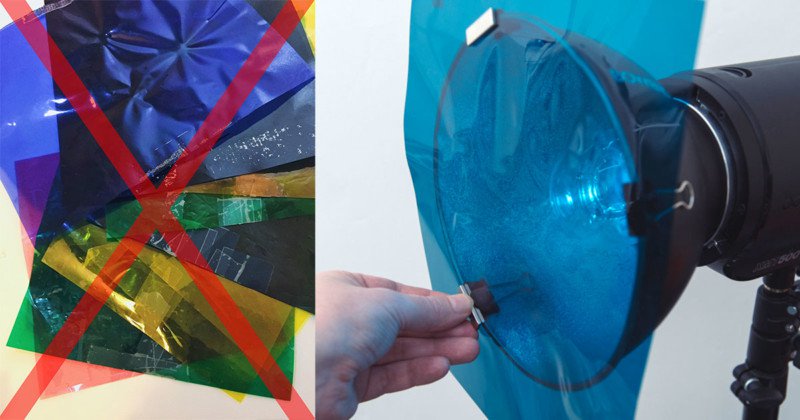
If you’re like me and you’ve tried to attach gels to your lights in the past, you’ve likely resorted to using one of the many types of sticky tapes available. When I used to manage a studio, I would see all manner of tapes being used to attach gels to hot modifiers.
From masking tape, duct tape, parcel tape and when they ran out, even regular old sticky tape was used. But ultimately, all of these tapes fell short in achieving their simple task of holding a colored gel in front of a light.
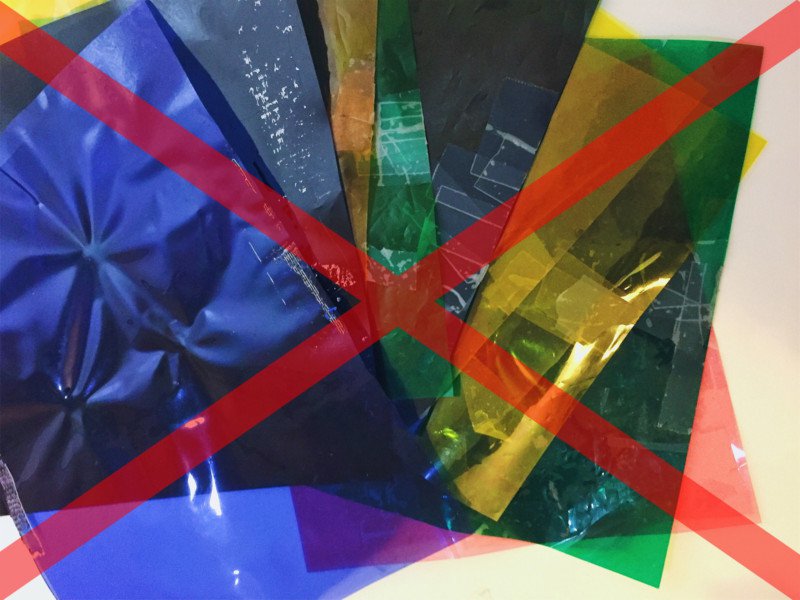
The Problem With Using Tape to Attach Gels
Put simply, most tapes are not designed to withstand heat. In fact, when most sticky tapes are subjected to sudden rises in temperature, their stickiness dries up and the gel inevitably falls off the lamp. There are tapes that can withstand this heat but they combat this by simply getting extremely gooey, which in turn leaves your gels in a right sticky mess that is certainly not conducive to long-term use.
An Alternative to Tape
By far and away the best solution I’ve found to this problem is to actually not use tape at all, but instead use magnets to attach your gels.
Magnets have a multitude of benefits; first and foremost being that they won’t ruin your gels in any way, plus they won’t stop working when they get hot either.
So What’s the Downside?
The biggest problem with using magnets in this way is that they only attach to magnet-friendly metal like steel. But alas most photographic modifiers are made of other metals like aluminum which have zero attraction to magnets whatsoever.
What’s the Solution?
So if our lighting modifiers are rejecting our magnets, we need to find an intermediary and that’s where the binder/foldback clip comes in. These little clips are nearly always made of thin steel and as such are more than happy to attract magnets. Simply clip them onto your modifiers and then attach the magnets to them whilst sandwiching the gel between the two. Job done.
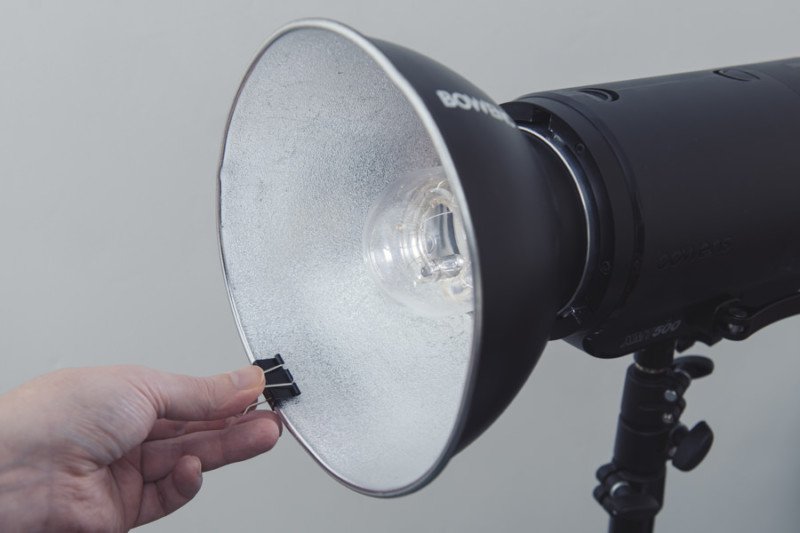
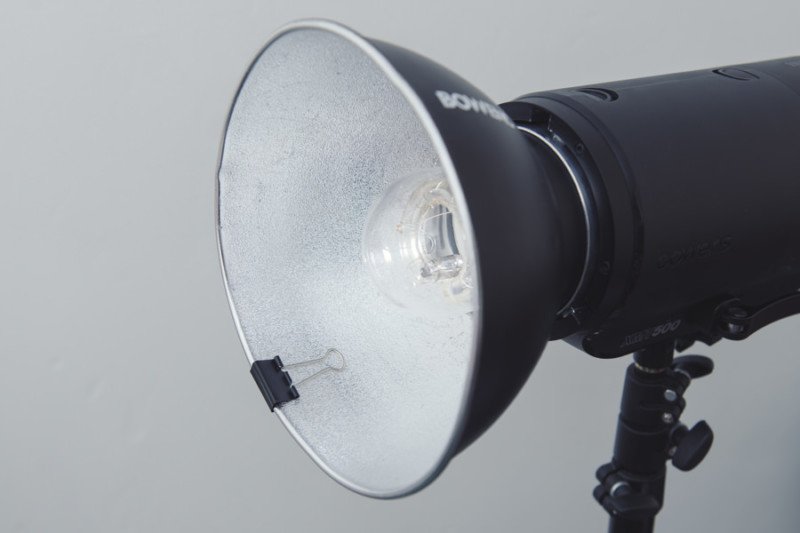
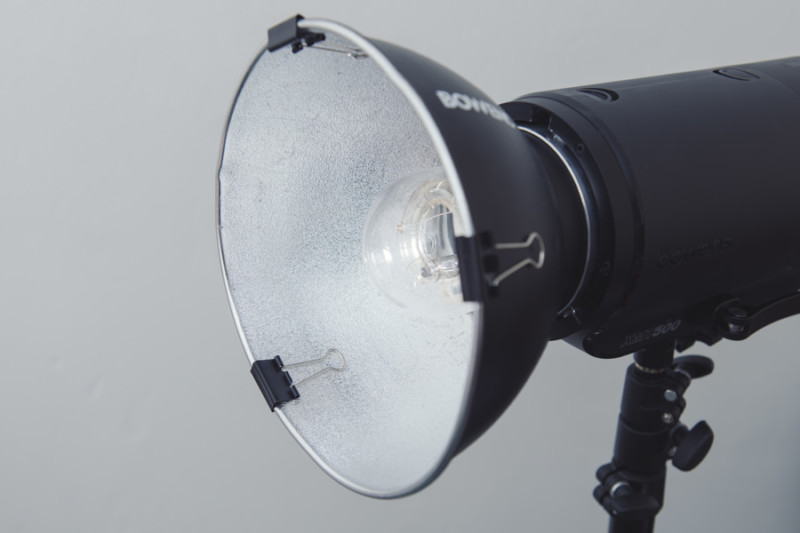
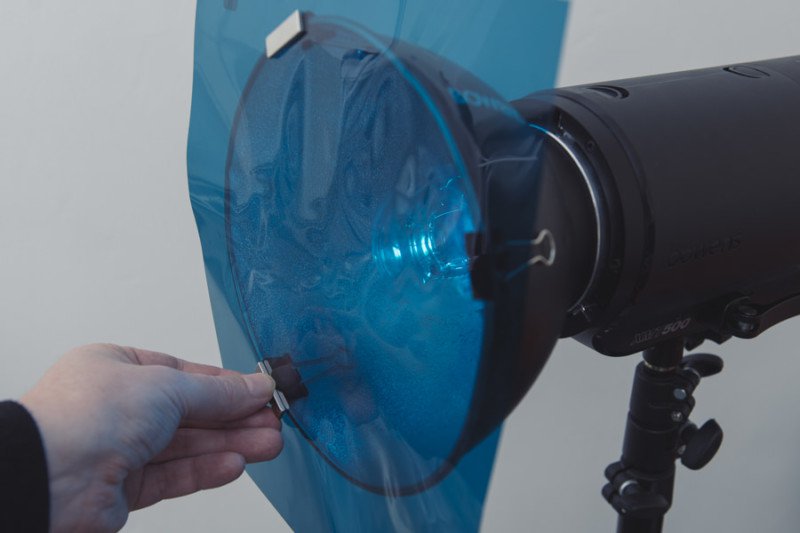
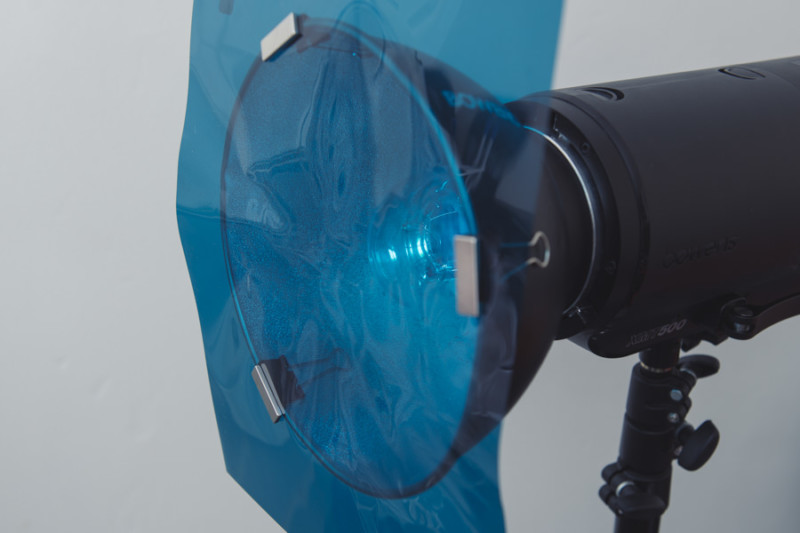
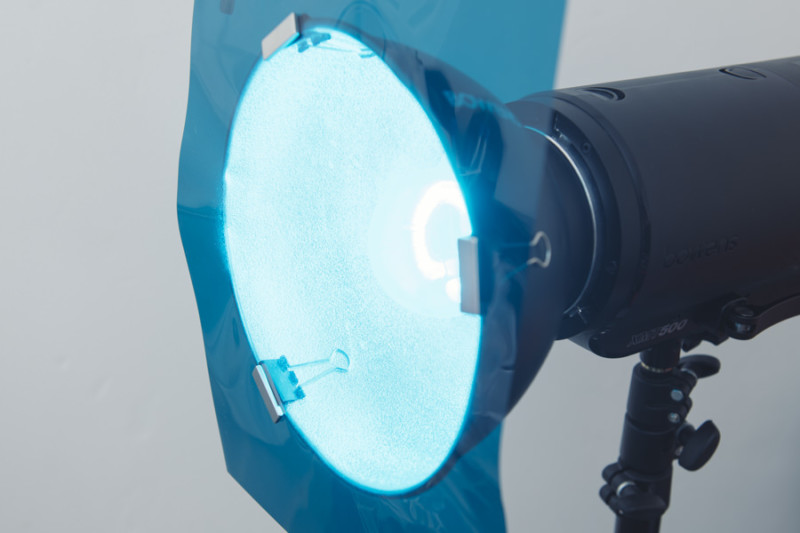
It really is as simple as that, plus it takes a matter of seconds to do. I also personally tend to leave the clips on all of my modifiers permanently, that way I don’t even need to add the clips each time I use them. The clips are super cheap, so buying a bunch of them and then applying 3 clips to each modifier is not a problem and they don’t get in the way of anything else either. That way all I need to do is add the magnets along with the gels each time.
Works on Any Dish Modifier
Like I mentioned earlier, this is a very simple process and the clips will attach to nearly any dish-type modifier, as we can see below.
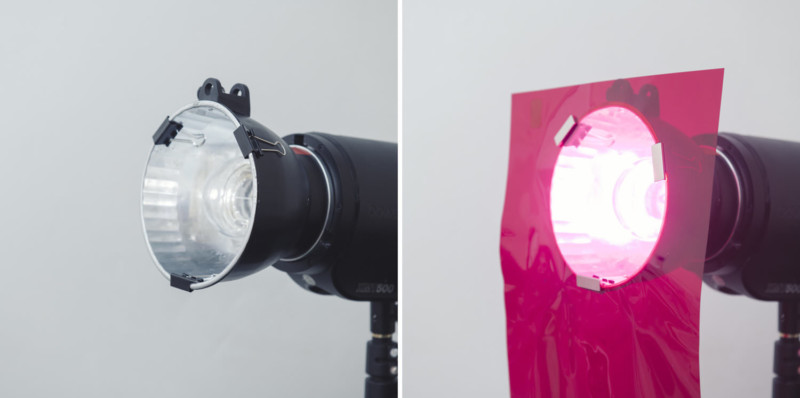
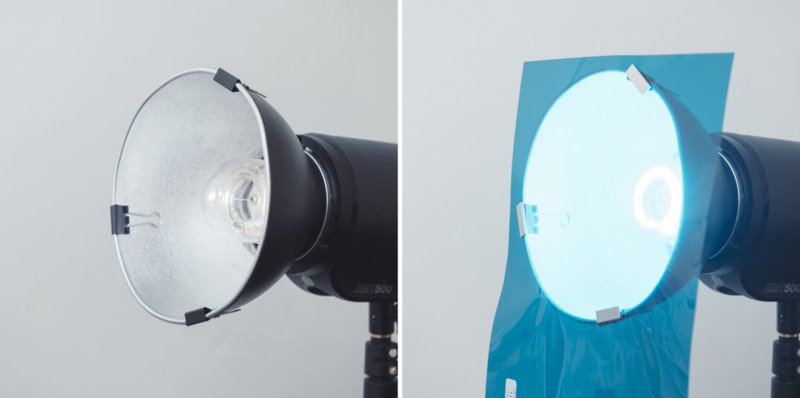
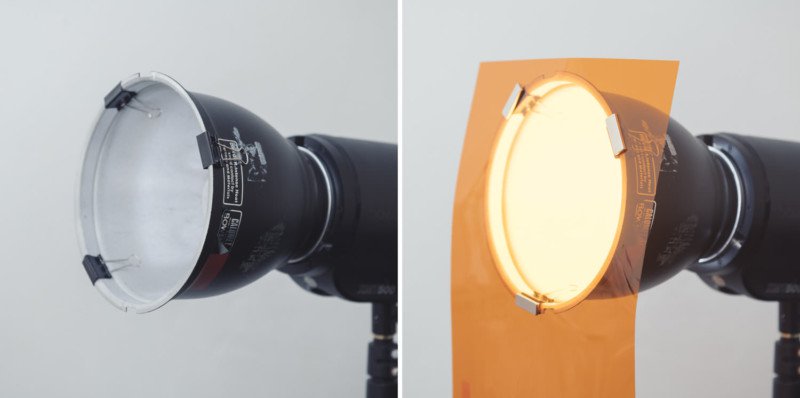
If you use the right size clips, they’ll even go over ‘lipped’ modifiers too. Plus the same clip and magnet combo will even work with the grids attached as well.
With the right size clips, you can even use the same method to attach gels with the grids in place too.

This method of attaching gels is so strong, you can use it to stack multiple gels on the same modifier. Using this clip and magnet trick you can hold an ND gel, a regular gel and a diffusion gel all on the same dish with ease. Attaching multiple gels in this way with tape was a real pain in the past.
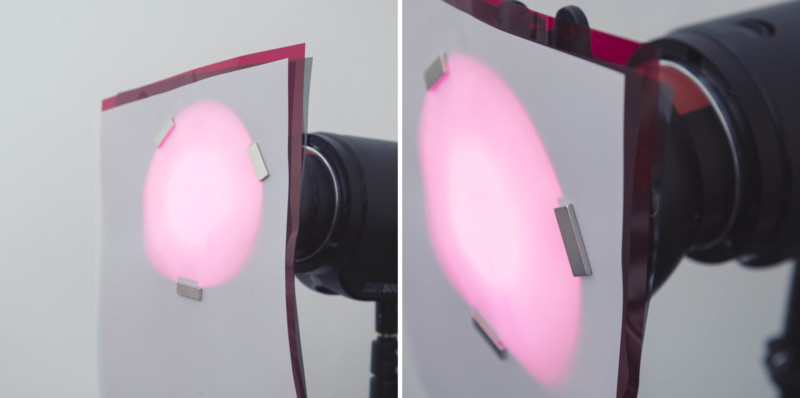
What You Will Need
As I said, this is super easy and most metal clip and magnet combo will work, but here’s what I personally use. I’ve tried a variety of different sized clips and magnets but this particular setup seems to work best for me as the clips work on all of my modifiers and the magnets are big enough and strong enough to hold stacks of multiple gels if need be.
Binder Clips

These are some of the smallest binder/foldback clips available and they measure about 1in/2.5cm at the base. Bigger ones will work but the smaller and lower profile clips work best in my opinion.
Simply search “binder clips” on Amazon or eBay. You should be able to get a 12-24 pack of these for just a few dollars.
Magnets
Again, any magnet will work but strong small ones are really what you’re looking for. The ones I use are typically referred to as ‘Rare Earth Neodymium Magnets’. These are remarkably strong magnets for their tiny size, so strong in fact, that getting fingers caught between stacks of them can be painful so they should be kept away from kids.

The ones I’m using are about 3cm long and about 1cm wide. These little attraction powerhouses are a bit more expensive than regular magnets, so if you can get away with using less powerful ones, go for it.
Simply search “rare earth magnets” on Amazon or eBay. A 20 pack of these should be around £15-£20.
Closing Comments
I’ll be honest, I’ve been using this gel attachment method for a while now and I was looking at manufacturing something to sell that was branded by me that did the same job. The problem was, it’s almost impossible to refine this incredibly simple idea into a product that didn’t overcomplicate the process.
This folding clip solution is just so perfect as their grips fold back out of the way and into the modifier itself. This then leaves that flat, even surface when closed that are perfectly suited to allow the magnets to sit flush on top of them.
Also, the super-strong rare earth magnets are already perfectly made to almost the exact same size as the clip itself. Plus this whole system works exactly the same way on any diameter dish from small umbrella holder dishes, to larger background dishes.
Designing a purpose-built product that actually did all of this better than these cheap little DIY alternatives, proved to be impossible! So in the end, I just decided to share it with you guys and maybe somebody else will figure out a better way (but I doubt it).
About the author: Jake Hicks is an editorial and fashion photographer based in Reading, UK. He specializes in keeping the skill in the camera and not just on the screen. If you’d like to learn more about his incredibly popular gelled lighting and post-pro techniques, visit this link for more info. Sign up to the Jake Hicks Photography newsletter and receive his free Top Ten Studio Lighting Tips and Techniques PDF. You can find more of his work and writing on his website, Facebook, 500px, Instagram, Twitter, and Flickr. This article was also published here.